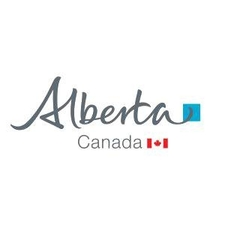MAPPING
Type of resources
Topics
Keywords
Contact for the resource
Provided by
Formats
Representation types
Update frequencies
status
-

Alberta Geological Survey partnered with Alberta Environment (AENV) Northern Region to compile and analyze groundwater data in the Cold Lake-Beaver River Drainage Basin. The compilation and analysis assisted AENV and its stakeholders to update the Beaver River-Cold Lake Water Management Plan. The project completed a digital, three-dimensional geological model of the area. This digital release contains the outlines of formation boundaries used in that report, specifically the boundaries for preglacial and glacial formations.
-

The dataset includes subsurface stratigraphic picks for the top of the Foremost Formation (Belly River Group) in the Alberta Plains (Townships 1 to 52, Ranges 1W4 to 5W5) made from downhole wireline geophysical well logs. The top of the Foremost was picked at the base of a continuous sandstone or siltstone bed (low-gamma-ray) of variable thickness overlying the Taber coal zone. Well data were screened to detect errors resulting from deviated wells, as well as incorrect ground and kelly bushing elevation data. We used statistical methods to identify local and regional statistical outliers, which were examined individually.
-

The dataset includes subsurface stratigraphic picks for the interfingering members that define the transition between the Belly River Group and the Lea Park Formation in east-central Alberta (Townships 1 to 62, Ranges 1W4 to 21W4) made from wireline geophysical well logs. Coarsening upwards, siltstone to sandstone-dominated members of the Belly River Group include (from youngest to oldest) the upper Birch Lake, lower Birch Lake, Ribstone Creek, Victoria, and Brosseau members. Interfingering mudstone-dominated members of the Lea Park Formation include the Mulga, Grizzly Bear, Vanesti, and Shandro members. Where the top and base are present, we calculated isochore values for each member. Well data were screened to detect errors resulting from deviated wells, as well as incorrect ground and kelly bushing elevation data. We used statistical methods to identify local and regional statistical outliers, which were examined individually.
-

The dataset includes subsurface stratigraphic picks for the base of the Belly River Group/Wapiti Formation in the Alberta Plains (Townships 1 to 94, Ranges 1W4 to 14W6) made from wireline geophysical well logs. In general, the pick was made at the base of the lowest sandstone bed (overlying the Pakowki or Lea Park Formation) that was overlain by coal. If coal is absent, the pick was made at the base of the first sandstone. We screened the well data to detect errors resulting from deviated wells, as well as incorrect ground and kelly bushing elevation data. We used statistical methods to identify local and regional statistical outliers, which were examined individually.
-

The dataset includes subsurface stratigraphic picks of the Milk River 'shoulder' in the Alberta Plains (Townships 1 to 73, Ranges 1W4 to 2W6) made from wireline geophysical well logs. The Milk River 'shoulder' is an informal term often used to refer to a distinctive 'shoulder' (deflection) on resistivity, sonic, density, and porosity logs. The Milk River 'shoulder' corresponds to the top of the Milk River Formation in southernmost Alberta, where it represents juxtaposition between paralic deposits of the underlying Deadhorse Coulee Member of the Milk River Formation and overlying marine shale of the Pakowki Formation. It is characterized by a leftward deflection (decreasing resistivity) upwards across the contact, forming the distinctive 'shoulder signature'. To the north, the Milk River 'shoulder' represents the boundary between the Alderson Member (lower Lea Park Formation) and the upper Lea Park Formation (Pakowki equivalent). In these areas, silty sands and mudstones of the Alderson Member are overlain by shales of the upper Lea Park Formation. Well data were screened to detect errors resulting from deviated wells, as well as incorrect ground and kelly bushing elevation data. We used statistical methods to identify local and regional statistical outliers, which we examined individually.
-

The dataset includes subsurface stratigraphic picks for the formations that comprise the Beaverhill Lake Group (Townships 29 to 113, Ranges 1W4 to 13W6) made from wireline geophysical well logs. The dataset also includes picks for the underlying Elk Point Group, and the overlying Woodbend Group. Lithostratigraphic picks for the Beaverhill Lake Group include the Fort Vermilion Formation, the Swan Hills Formation, the Slave Point Formation, and the Waterways Formation (top of the Beaverhill Lake Group). Lithostratigraphic picks for the underlying Elk Point Group include the Prairie Evaporite Formation, the Sulphur Point Formation, and the Watt Mountain Formation (base of the Beaverhill Lake Group). Lithostratigraphic picks for the overlying Woodbend Group include the Cooking Lake Formation, or its equivalent.
-

This dataset accompanies Open File Report 2009-02. Between 1971 and 1983, the Alberta Research Council created a series of hydrogeological maps of Alberta. The geologists examined the sediment types present and used existing water well information to assign yield values to distinct zones within the mapped areas. They also looked at the materials, generally to a depth of 305 metres (1000 feet) below ground surface, and added the yields of the sediments encountered within this interval to arrive at a yield value for the whole. Alberta Geological Survey compiled the shapefiles for the yield polygons, digitized by the Prairie Farm Rehabilitation Agency, and then digitized the remaining linework for the remaining map areas. Afterwards, we created a geodatabase of the yield polygons for the entire province and assigned yield values to the polygons based on the original maps. We also assigned the most likely formation name, age and lithology to the yield polygon.
 Arctic SDI catalogue
Arctic SDI catalogue